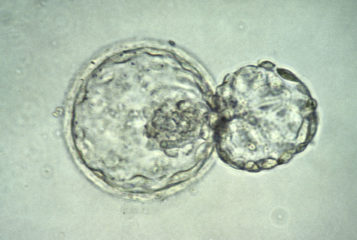Fertility scientists are calling for greater transparency around the composition of embryo culture media used in IVF, after research comparing two solutions found different outcomes in implantation success rates and birth weight.
'If the culture medium can do that, what else can it do? What might come out in 20 or 30 years?', asked Dr John Dumoulin of Maastricht University Medical Centre in the Netherlands, who led the research. The study was published in Human Reproduction.
Culture media is the solution in which embryos are grown for the first few days during IVF treatment, prior to implantation in the uterus. This study is the first randomised and controlled trial to compare the effects of different media used by fertility clinics upon embryos.
Dumoulin and his team studied 836 couples in the Netherlands who were already scheduled for IVF treatment, and randomly allocated them one of two common IVF culture media, G5 or human tubule fluid (HTF). The progress of their IVF treatment was followed for a year, or until birth in the case of successful pregnancies.
The team found that using G5 solution led to a higher number of viable embryos (2.8 versus 2.3), and higher rates of successful fresh embryo implantation (20.2 percent vs 15.3 percent) and pregnancy (47.7 percent vs 40.1 percent), compared to HTF.
However, G5 babies also had a lower birthweight, by an average of 158g. Dumoulin cautioned that it cannot be interpreted yet whether G5 is better or worse than HTF. He called for greater scrutiny and randomised testing of commercial embryo culture media.
The composition of different commercial culture media can vary widely. A review paper by a working group of the European Society of Human Reproduction and Embryology found that while companies might list the components of the solution, they don't provide the proportions or concentrations used. There is currently no uniform regulation of embryo culture media and fertility clinics select media according to their own preferences.
'The key issue is that we must know the composition of the culture media we use, since it seems to induce differences in the make-up of the children born,' said Professor Hans Ever, an editor of Human Reproduction, who wrote an accompanying editorial to the study. 'We have no information about long-term consequences of this, but we cannot rule out that the composition of the culture media may affect the health of children as they grow up and become adults.'
'I think the time has certainly come to ask the manufacturers of these media to be upfront and clear about what they put in them', said Allan Pacey, professor of andrology at the University of Sheffield, who was not involved in the study. 'It beggars belief that in this day and age of food labelling and the regulation of medicines that this is not already done.'
Sources and References
-
First randomized trial shows IVF culture media affect the outcomes of embryos and babies
-
BabiesÔÇÖ health could be affected by variation in IVF nutrients
-
Influence of embryo culture medium (G5 and HTF) on pregnancy and perinatal outcome after IVF: a multicenter RCT
-
Peanut butter
-
Time to take human embryo culture seriously





Leave a Reply
You must be logged in to post a comment.